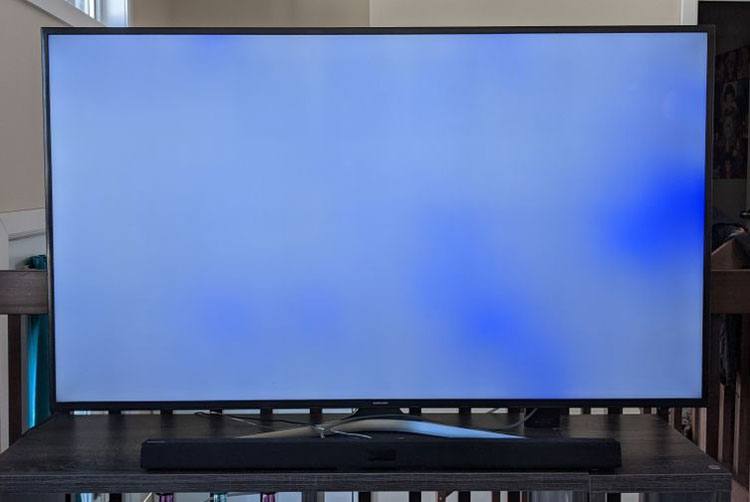Seeing a blue light on your TV can be frustrating. Don’t worry; fixing it is often simple.
Blue light issues on TVs are common and can stem from various sources. Sometimes, it’s a minor setting problem, while other times it may involve hardware. Understanding the cause is key to resolving the issue. This guide will help you troubleshoot and fix the blue light on your TV.
We’ll explore easy steps and solutions that anyone can follow. Whether it’s a quick adjustment or a deeper fix, you’ll find clear instructions here. Read on to learn how to get your TV back to normal.
Table of Contents
ToggleCauses Of Blue Light
Understanding the causes of blue light on your TV can help you fix the issue. Blue light on TVs often results from two main factors. These are LED backlighting and color calibration issues. Knowing these causes allows you to take corrective actions. Let’s dive into each cause.
Led Backlighting
LED backlighting is a common source of blue light in modern TVs. LED TVs use light-emitting diodes to illuminate the screen. These LEDs often have a blue tint, especially in cheaper models. This blue tint can become more noticeable over time. Regular use can intensify the blue light, affecting your viewing experience. Adjusting the backlight settings can reduce this blue tint. Look for settings in your TV’s menu to change the backlight intensity. Reducing the backlight can lessen the blue light emitted.
Color Calibration Issues
Color calibration issues also contribute to blue light on your TV. Incorrect color settings can cause the screen to appear blue. TVs come with preset color modes, which may not be accurate. Calibrating your TV can fix this blue tint. Use the TV’s settings menu to adjust color balance. Look for options like “Color Temperature” or “White Balance.” Set these options to neutral or warm tones. This adjustment can help reduce blue light and improve picture quality.

Credit: technastic.com
Impact Of Blue Light
Blue light from TVs impacts our health in multiple ways. This section explores how it affects our eyes and sleep. Understanding these impacts can help you take steps to minimize them.
Eye Strain
Blue light can cause significant eye strain. Staring at the TV for long periods makes your eyes tired. You might experience headaches and dry eyes. Reducing screen time can help alleviate these symptoms.
Sleep Disruption
Blue light can disrupt your sleep. It affects your body’s natural sleep cycle. Watching TV before bed makes it harder to fall asleep. You may wake up feeling tired. Limit TV time before sleeping to improve rest.
Adjusting Tv Settings
Adjusting your TV settings can help you fix the blue light issue. Incorrect settings might be causing the problem. By making simple tweaks, you can improve your viewing experience.
Brightness And Contrast
Adjusting the brightness and contrast settings can reduce the blue light. Lowering the brightness can make the screen less harsh. Follow these steps:
- Open your TV’s settings menu.
- Navigate to the Picture or Display settings.
- Adjust the Brightness setting to a lower level.
- Next, find the Contrast setting and tweak it as needed.
Experiment with these settings until you get a comfortable picture. Too much contrast can make the blue light more noticeable.
Color Temperature
The color temperature setting affects the overall color tone of your TV screen. Adjusting it can reduce the blue light. Here’s how:
- Go to your TV’s settings menu.
- Look for the Picture or Display settings.
- Find the Color Temperature option.
- Change it to a warmer setting, such as Warm or Custom.
A warmer color temperature can make the screen look more natural. It can also help reduce eye strain caused by blue light.
By adjusting these settings, you can make your TV viewing more pleasant and less harmful to your eyes.

Credit: www.youtube.com
Using Blue Light Filters
Blue light from TV screens can strain your eyes and affect sleep quality. Using blue light filters can help reduce this strain and improve your viewing experience. Here’s how to fix blue light on TV using blue light filters.
Built-in Tv Filters
Many modern TVs come with built-in blue light filters. These filters adjust the screen settings to reduce blue light emission.
- Open your TV’s settings menu.
- Navigate to the display or picture settings.
- Look for a setting called “blue light filter” or “night mode”.
- Turn on the filter and adjust the level as needed.
These filters are easy to use and require no additional equipment.
External Filter Options
If your TV doesn’t have built-in filters, you can use external options. These filters are physical screens or glasses that reduce blue light.
External filters:
| Type | Description |
|---|---|
| Screen protectors | Attach to your TV screen and filter blue light. |
| Blue light glasses | Wear these to filter blue light while watching TV. |
Both options are effective and provide additional eye protection.
Use these methods to reduce blue light from your TV screen and enjoy a more comfortable viewing experience.
Optimizing Room Lighting
Optimizing room lighting can significantly reduce the blue light emitted by your TV. This adjustment can improve your viewing experience and protect your eyes. Let’s explore some effective strategies.
Ambient Light Adjustment
Adjusting the ambient light in your room can help balance the light levels. Aim for a soft, warm light that doesn’t create glare on your TV screen. Here are a few tips:
- Use dim lights or lamps with adjustable brightness.
- Avoid placing lights directly opposite the TV.
- Choose bulbs with a color temperature of 2700K to 3000K.
- Consider using smart bulbs that can change color and intensity.
Room Layout
Your room layout plays a crucial role in optimizing lighting. A well-arranged room minimizes blue light effects:
- Place the TV away from windows to avoid reflections.
- Position seating areas at a comfortable distance from the TV.
- Ensure the TV is at eye level to reduce strain.
- Use curtains or blinds to control natural light.
Here’s a quick reference table for room layout tips:
| Tip | Details |
|---|---|
| TV Placement | Away from windows |
| Seating Distance | Comfortable viewing distance |
| TV Height | At eye level |
| Natural Light Control | Use curtains or blinds |
By optimizing your room lighting, you can enjoy a better and healthier TV viewing experience.
Software Solutions
Fixing the blue light issue on your TV doesn’t always need hardware changes. Sometimes, software solutions can solve the problem easily. Let’s explore some of these solutions, focusing on third-party apps and firmware updates.
Third-party Apps
Third-party apps can help manage the blue light on your TV. These apps adjust the screen settings to reduce blue light emission. Here are some popular apps:
- f.lux: Adjusts the screen color temperature based on the time of day.
- Twilight: Filters blue light and adapts the screen’s color temperature.
- Night Mode: Creates a warmer screen light to reduce eye strain.
Using these apps is simple. Download the app from your TV’s app store. Follow the setup instructions. Adjust the settings to your preference. You can control the blue light easily with these apps.
Firmware Updates
Updating your TV’s firmware can also help fix the blue light issue. Firmware updates often include new features and fixes for bugs. Here’s how to update your TV’s firmware:
- Go to your TV’s Settings menu.
- Select System or About.
- Choose Software Update or Firmware Update.
- Follow the on-screen instructions to complete the update.
Keep your TV’s firmware up-to-date. This ensures you have the latest fixes and features. Check for updates regularly to maintain optimal performance.
Protective Eyewear
Protective eyewear can help reduce the impact of blue light from your TV. Blue light can cause eye strain, headaches, and poor sleep. Wearing protective eyewear is an easy and effective solution. Let’s explore some options.
Blue Light Blocking Glasses
Blue light blocking glasses are designed to filter out blue light. They look like regular glasses but have special lenses. These lenses block or absorb blue light. Wearing them while watching TV can make a big difference.
You can find blue light blocking glasses online or in stores. They come in various styles and price ranges. Some have clear lenses, while others are tinted. Choose a pair that you find comfortable and effective.
Screen Shields
Screen shields are another option to protect your eyes from blue light. These shields are easy to attach to your TV screen. They work by blocking a portion of the blue light emitted by the screen.
Screen shields are made from special materials that filter blue light. You can remove them when not needed. They are an affordable and convenient way to reduce eye strain. Consider using both glasses and screen shields for extra protection.
Healthy Viewing Habits
Watching TV can be fun, but it’s important to develop healthy viewing habits. These habits help reduce eye strain and improve your overall well-being. Two key habits are taking regular breaks and maintaining a proper viewing distance.
Regular Breaks
Staring at the TV for long periods can strain your eyes. To avoid this, take regular breaks. Every 20 minutes, look away from the screen for at least 20 seconds. Focus on something 20 feet away. This simple exercise relaxes your eye muscles.
During breaks, stand up and stretch. Move around to get your blood flowing. This helps reduce fatigue and keeps you alert. Remember, short breaks can make a big difference.
Proper Viewing Distance
Sitting too close to the TV can harm your eyes. Maintain a proper viewing distance to ensure a comfortable experience. A good rule of thumb is to sit at a distance that is about 1.5 to 2.5 times the diagonal size of your TV screen.
For example, if your TV is 40 inches, sit between 5 to 8 feet away. Adjust the distance to what feels most comfortable for you. Make sure the TV is at eye level to reduce neck strain.
By following these tips, you can enjoy your favorite shows without harming your eyes. Healthy viewing habits are simple but very effective.

Credit: www.reddit.com
Frequently Asked Questions
Why Is My Tv Showing A Blue Light?
A blue light on your TV can indicate an issue with the display, HDMI connection, or internal hardware.
How Do I Reset My Tv To Fix The Blue Light?
Unplug the TV, wait 60 seconds, then plug it back in. This resets the TV.
Can A Firmware Update Fix The Blue Light Issue?
Yes, updating the TV’s firmware can resolve bugs causing the blue light issue. Check for updates.
Does Changing Hdmi Cables Help With The Blue Light?
Yes, faulty HDMI cables can cause a blue light. Try using a different HDMI cable.
Conclusion
Fixing the blue light on your TV can be simple. Follow the steps mentioned, and your screen should be clear. Adjusting settings can make a big difference. If problems persist, consider contacting a professional. Regular maintenance keeps your TV in good shape.
Enjoy better viewing with proper screen settings. A little effort goes a long way. Happy watching!







